
by Pat Williams | Sep 14, 2020
Did you ever want to grow something for the dinner table in your yard, but said “I don’t have the space”, or “I don’t have the time”, or “it seems like a lot of hard work or even I have restrictions because of the homeowner’s association I live in”?
If so, then foodscaping might be the answer to growing food in your yard. Landscape beds have traditionally been planted with trees, shrubs, groundcovers, flowers and even vines while edibles were relegated to garden plots containing vegetable and herbs. Foodscaping is a growing trend that takes edibles from formal vegetable plots into landscape beds.
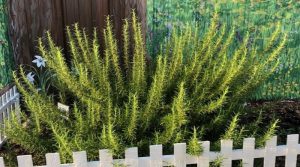
Rosemary in the UF/IFAS Extension Wakulla entrance bed.
Foodscaping works for both newly planted landscapes and established ones. Only a few square feet are needed to begin. When most new landscapes are planted, they space plants apart for future mature growth. Until the shrubs fill in, you have usable space. The same holds true for established landscapes. Sometimes there is empty space. Whatever the cause, there now is a foodscaping opportunity.
Some of the best examples of beginning foodscaping plants are herbs and greens. A good number of cooking herbs are perennials and can add seasonal accent to the yard and flavor in the kitchen. Some examples are oregano*, thyme, rosemary, sage, lemongrass, chives, garlic chives, winter savory, mints*, chamomile, lavender, and lovage (* containers will help control the spread).
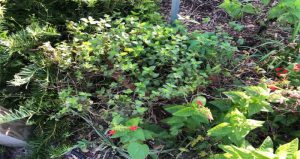
Potted chocolate mint between red salvia and yew.
Some annuals herbs include dill, fennel, cilantro/coriander, basil, garlic, sweet marjoram (perennial but acts like an annual in colder areas) and tarragon. These herbs are compact, just one or two plant in a space with a bit of room to grow is all that’s needed. Other vagetables that offer a seasonal groundcover look are greens like assorted leaf lettuces, spinach, mustard, bok choy, collards, sorrel, burnet, parsley and kale. These herbs and vegetables attract the senses with their colors, textures, and fragrances.
Once you get the hang of these easier foodscaping plants, you can branch out into more traditional garden favorites like potatoes, sweet potatoes, green beans, peas, beets, radishes, celery or anything that fits the space and cultural/environmental requirements.
Besides having some quick and easy items to eat from the yard, you are also doing your bit for the environment by reducing vehicle travel, which reduces your carbon footprint. And if you have extra, share with your neighbors and encourage them to foodscape as well. For more information check out https://gardeningsolutions.ifas.ufl.edu/design/types-of-gardens/foodscaping.html.
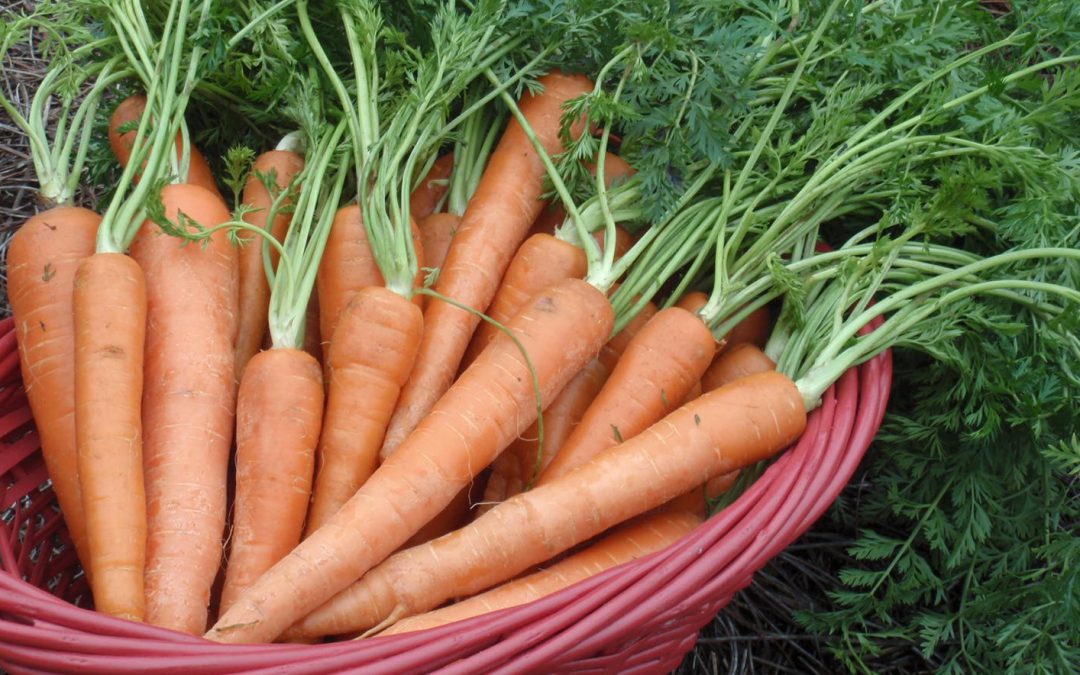
by Beth Bolles | Sep 8, 2020
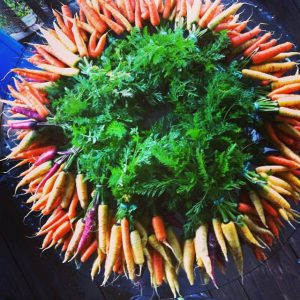
The modern carrot is available in many sizes, colors, and flavor profiles thanks to thousands of years of plant breeding. Photo by Kelly Thomas.
The University of Florida Vegetable Gardening Guide is a wonderful resource for those who are getting started gardening and growing some edible plants. As you look through the publication, you will see a chart for the different portions of Florida about when to start different fruits and vegetables. Remember this is just a guide. We may have to adjust some of our starting dates depending on local temperatures and other weather patterns.
A good example is that the guide states to start carrots beginning in August. For many years now our August temperatures are just too hot for starting carrots. Portions of September in North Florida may also be too warm for carrots. The ideal temperatures for growing carrots are 75 degree F. days and 55 degree F. nights. We need to at least wait until our temps are in the low to mid 80’s before even trying carrot seeds.
When you plant your carrot seeds, they will need good moisture to germinate. Be patient. Carrots are not always the fastest to come up. It normally takes at least 7 days for germination to occur and can take a little longer at times.
Use the Florida Vegetable Gardening Guide as a way to help you plan for your next fun gardening experience. Add in the expertise of your local county Extension Agent, along with local observations about current weather, and you will have success in your home garden.

by Ray Bodrey | Aug 24, 2020
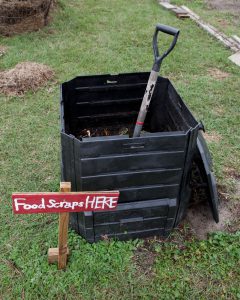
Figure: Increase water holding capacity through home composting.
Credit: Tyler Jones, UF/IFAS Communications.
Water is a precious resource for Floridians, even if the last couple of months of rainfall may make you think otherwise. As home gardeners, we should keep water conservation in mind.
Wasting water now may cause restrictions in the future, as basic water needs of a growing population outpace capacity. Of course, we all hope that’ll never happen, but it is possible.
As we start planning for our fall vegetable garden, let’s think about conserving water usage. We can start by putting our “plant biology” cap on. A great way to save water is to plant fast growing, early-maturing vegetables. The strategy, of course, is the sooner a plant matures the less water it will need.
Gardening periods in Florida vary, too. Thus, there are broad choices of planting dates for many vegetables. For Panhandle gardeners, the current trend has shown dry periods in the spring, but adequate rainfall in summer months. Usually with the seasonal change to fall, soil moisture holding capacity is not a great struggle in Panhandle. However, much of our soils consist of coarse sandy particles, which are not ideal for water holding capacity. Amending garden soils with organic materials such as compost, manures, and cover crops, will help the soil hold water better.
Selecting the right irrigation method is also a great way to conserve water. Overhead sprinkling is not ideal for most gardening applications. This method wastefully projects water into areas between rows, outside of root zones and allows for much evaporation loss. Drip irrigation can help solve these issues, by concentrating water directly to the root system. IFAS research has estimated an 80% reduction in water usage when utilizing a drip system.
If drip irrigation isn’t a method you’re interested in, overhead watering the garden thoroughly twice weekly is an acceptable alternative. Remember, there’s a limit to how much water plants can use. Excess water can cause runoff and consistent heavily saturated soils may promote root rot. Mulching also ranks highly among water conservation practices, by allowing the soil to hold more moisture. Examples of mulch types include hay, straw, leaves or plastic.
Supporting information for this article can be found at the UF/IFAS gardening solutions website.
For planting information, please see the Florida Vegetable Gardening Guide.
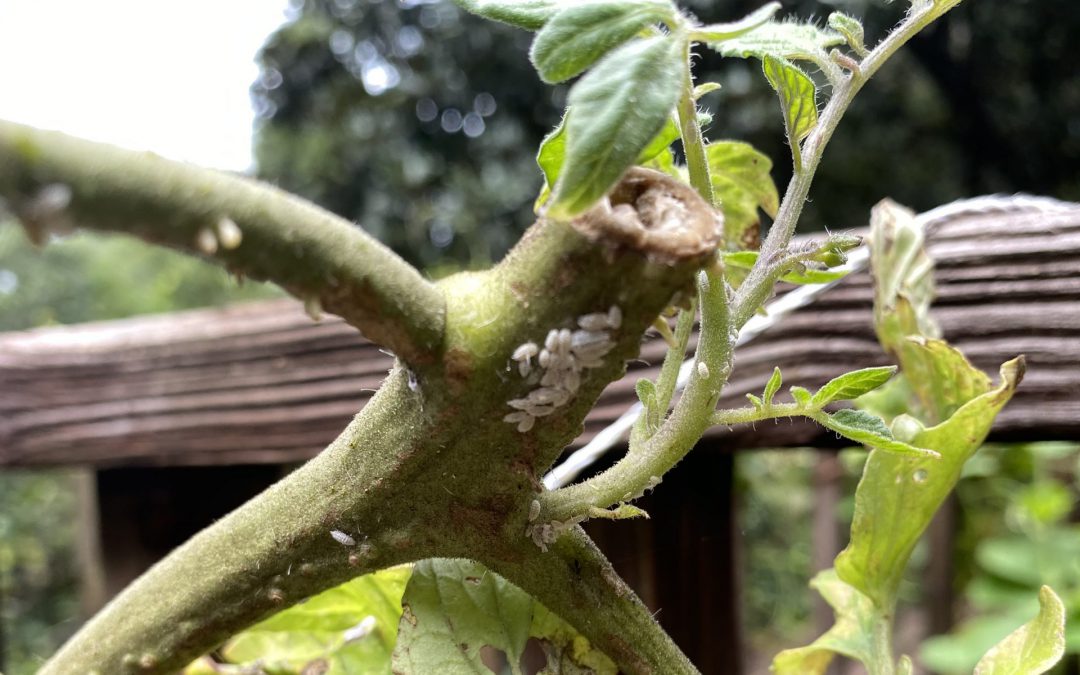
by Matt Lollar | Aug 24, 2020
A common question for gardeners at the end of the season is if one should till the soil or use no till practices. Opinions vary regarding this question, even among Extension Agents. However old crops harbor insects, both good and bad. This phenomenon was noticed on some recently cut back tomato plants. The intention was to cut the leftover spring garden tomatoes back to encourage fall production. Instead, a host plant for mealybugs was provided.
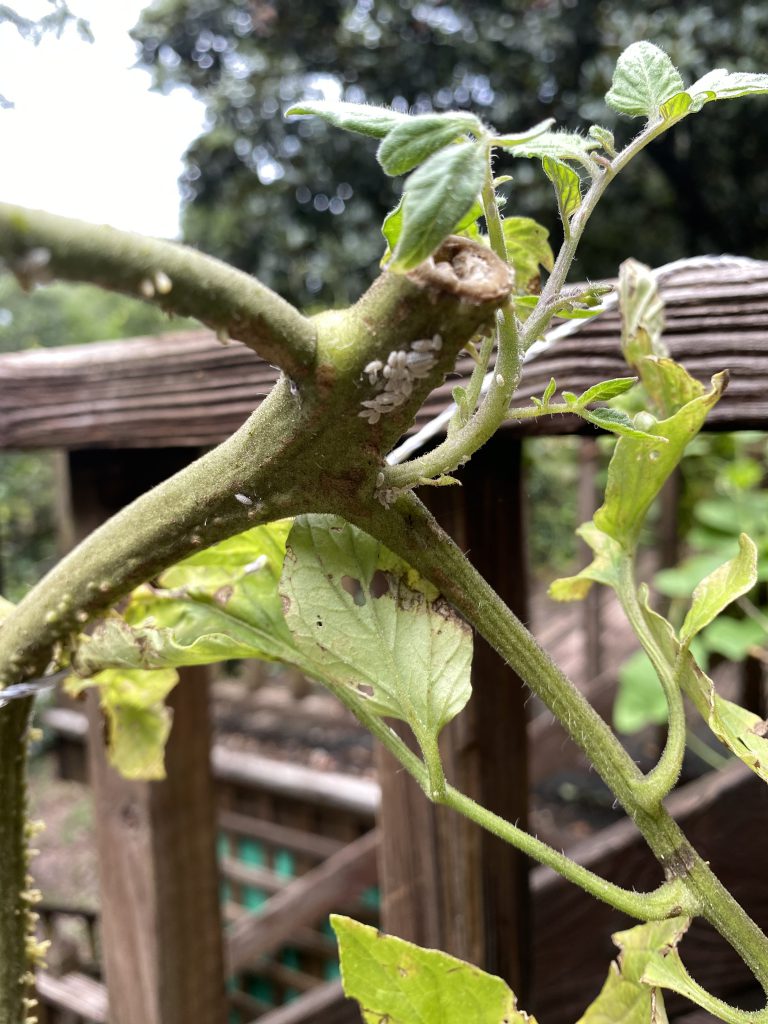
Mealybugs on a tomato plant. Photo Credit: Matt Lollar, University of Florida/IFAS Extension – Santa Rosa County
Mealybugs are soft-bodied insects that possess a covering of flocculent, white, waxy filaments. They are about 1/8 inch in length and usually pinkish or yellowish in color. Mealybugs have piercing-sucking mouthparts which they use to siphon fluids from the leaves, stems, and sometimes roots of many ornamental and vegetable plants. Mealybug damage produces discolored, wilted, and deformed leaves.
One very common example of an insect pest likely to claim residence in your garden’s crop residue, are squash bugs. They like to overwinter on squash, cucumber, and other cucurbit crop residue. If you choose to not till your garden and leave a portion of last seasons crop in your garden, then you should consider applying an insecticide to your spent crop at the end of the season. A product containing a pyrethrin or pyrethroid as an active ingredient would be a good broad spectrum insecticide to control any pest that may reside on plant residue. More information on pyrethrins and pyrehtroids can be found at the EPA webpage: Pyrethrins and Pyrethroids. If you choose to apply an insecticide, it is important that you follow the information on the label regarding pollinator protection. Another option is to plant a trap crop on the edge of your garden to help attract pest insects away from your desired crops. More information on trap crops can be found in the EDIS Publication: Intercropping, Pest Management and Crop Diversity.
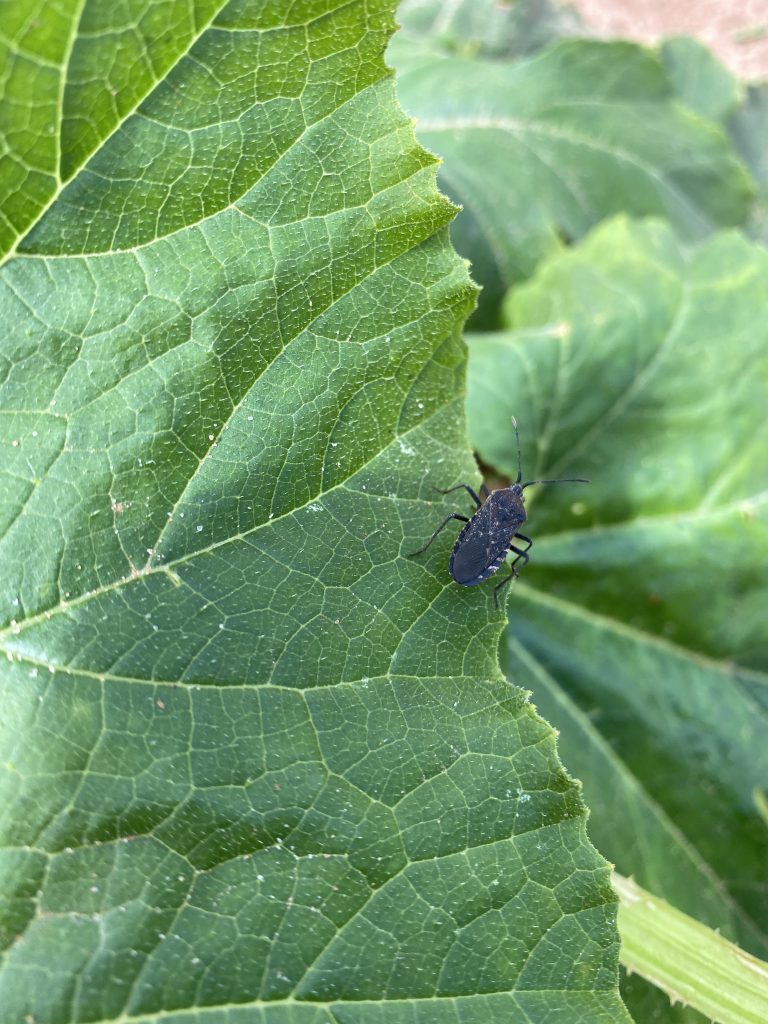
An adult squash bug on a zucchini leaf. Photo Credit: Matt Lollar, University of Florida/IFAS Extension – Santa Rosa County
So the answer to the till or no till question is…it depends. It is really up to the gardener. Yes, the residue from crops will add nutrients and organic matter to your soil, but it could also increase pest pressure in your garden. If you don’t plan to remove crop residue and don’t plan to till, then keep an eye out for what could be hiding in your garden.
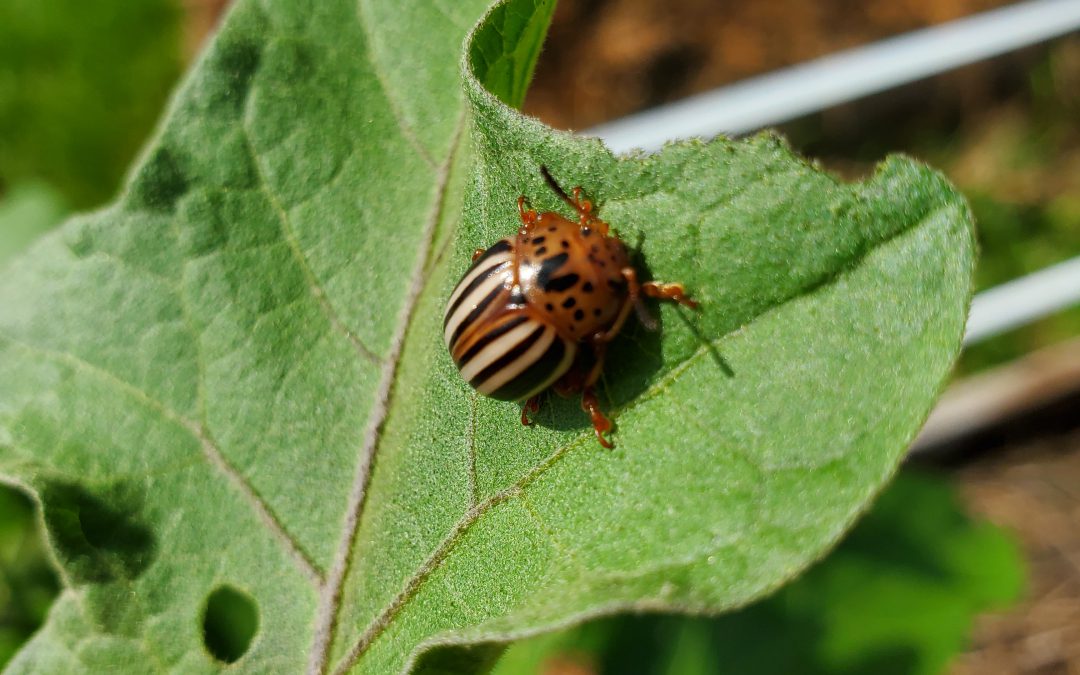
by Daniel J. Leonard | Aug 24, 2020
August is awful. Its heat makes one miss the relative cool of July. Its rain is so sporadic that it invokes nostalgia for the rainy afternoons of early summer. But if there is a silver lining in August for gardeners, it is the simplicity that it brings. The weaker spring crops, tomatoes, squash and the rest, are all gone now, destroyed or rendered fruitless by insects, disease, and heat. This leaves only the hardened, usually pest and disease-free survivors Okra, Pepper, Sweet Potato and Eggplant. I say usually because, this year, my eggplant bed is under attack by a new-to-me pest, the False Potato Beetle!
I’ve dealt with Colorado Potato Beetles (CPB) before. Those orangish, black-striped terrors often attack my spring potato crops and occasionally bother early tomatoes. However, I’ve never seen them in late summer on Eggplant. This raised suspicion. Also, I spotted unusual, round, whitish purple creatures munching on leaves from the same plants; these appeared to be the larval stage of the unidentified beetle. A little digging led me to identify these garden pests as the lesser known, lookalike cousin of CPB, the False Potato Beetle.
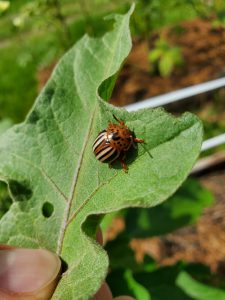
False Potato Beetle munching on an Eggplant leaf in the author’s garden.
False Potato Beetle (FPB) looks nearly identical to its cousin in the adult stage. They are similarly shaped and colored, though a close look reveals subtle differences between species. While both have yellowish-orange heads and pale-yellow backs with dark stripes, the FPB’s back is slightly lighter hued, more of a whitish, cream color. Also, the CPB’s underside and legs are a very dark orange to brown, with the False Potato Beetle having lighter colored legs and underside. If you’re saying, “These old eyes will never be able to tell the difference, County Agent. Cream and light-yellow look the same to me.”, I get it. Fortunately for those of us with poor vision, the larval stage (babies) of the two beetles looks very different and is the key to correct ID! FPB larvae are larger and have a whitish coloration. CPB larvae, in contrast, are a similar burnt orange color to the adult beetle. I promise, the difference is very distinguishable!
False Potato Beetle is considered a minor garden and agronomic pest as they typically only bother Eggplant, and they don’t usually destroy entire plants. However, if you get a FPB outbreak in your Eggplant garden, they can still be pretty destructive. These beetles feed in the same manner as caterpillar pests, chewing away entire sections of leaves and stems. Unchecked infestations can defoliate entire sections of plants. So, if you find these little beetles eating away at your eggplant garden, what can you do?
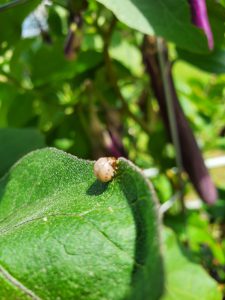
False Potato Beetle larvae. Photo courtesy of the author.
First, if you scout regularly, you’ll notice the beetles and their larvae in relatively small numbers before outbreaks become widespread. I had pretty good success this year just catching infestations early and picking off the beetles I saw and squishing them. Continue scouting and squishing for a few days and pretty soon, the population is reduced to a manageable level. However, if squishing makes you squeamish, you also have some common pesticide options at your disposal. I normally encourage clients to start their chemical pest control strategy with “softer” products like Pyganic, a pyrethrin make from an extract from the Chrysanthemum plant. Pyganic works great but is a little harder to find; you may have to order online or ask your local retailer if they can get it for you. If you are unable to find Pyganic or it doesn’t perform for you, the old standby products with carbaryl or pyrethroids (Sevin, Ortho Bug-B-Gone, and others) also work well.
False Potato Beetle can be a late summer garden pain, but with regular scouting, proper insect ID, lots of squishing, and maybe a timely pesticide application or two, you should be able to continue to harvest eggplant deep into fall! If you have FPB in your garden or have another horticultural question, give your local UF/IFAS County Extension office a call! Happy Gardening!
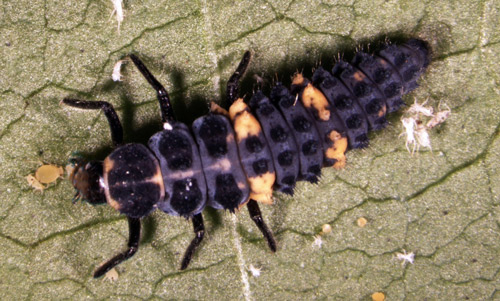
by Daniel J. Leonard | Aug 6, 2020
I know this is going to come as a shock to some readers, but not all bugs are bad. In fact, while there are over 1 million species of insects worldwide, less than 1% are problem pests! This problem 1%, composed of common garden pests, including aphids, stinkbugs, nuisance caterpillars, and scales, get all the attention and for good reason; they can be extremely destructive to home and commercial crops. However, the good guys, beneficial predatory insects, are out there too, providing valuable pest control day and night and should be considered in part of a quality garden pest management strategy.
 Beneficials come in many shapes and sizes. Some are commonly known predators, such as spiders, Lady Beetles and Praying Mantids, while others are lesser known pest nemeses, like Paper Wasps, Pirate Bugs, and Lacewings. Regardless, gardeners should do their homework and be able to identify beneficials when they see them and allow them to do their jobs. The presence, or not, of a handful of Lady Beetles or Lacewings on the attack can be the difference between needing to treat with insecticides for an aphid outbreak or just letting nature take its course. Studies have shown that just one individual Lady Beetle in the larval stage can consume as many as 500 aphids; adult Lady Beetles are even hungrier aphid eaters! Paper Wasps, you know the ones who make the large “papery” nests around eaves of house and other structures, play an important beneficial role, frequently preying on caterpillars. If their nests aren’t near highly trafficked areas around your home and you don’t have family members allergic to wasp stings, your garden will thank you for leaving a few paper wasp colonies as caterpillar insurance!
Beneficials come in many shapes and sizes. Some are commonly known predators, such as spiders, Lady Beetles and Praying Mantids, while others are lesser known pest nemeses, like Paper Wasps, Pirate Bugs, and Lacewings. Regardless, gardeners should do their homework and be able to identify beneficials when they see them and allow them to do their jobs. The presence, or not, of a handful of Lady Beetles or Lacewings on the attack can be the difference between needing to treat with insecticides for an aphid outbreak or just letting nature take its course. Studies have shown that just one individual Lady Beetle in the larval stage can consume as many as 500 aphids; adult Lady Beetles are even hungrier aphid eaters! Paper Wasps, you know the ones who make the large “papery” nests around eaves of house and other structures, play an important beneficial role, frequently preying on caterpillars. If their nests aren’t near highly trafficked areas around your home and you don’t have family members allergic to wasp stings, your garden will thank you for leaving a few paper wasp colonies as caterpillar insurance!
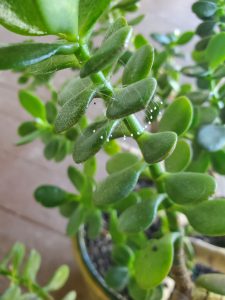
Lacewing eggs on a Jade plant in close proximity to the author’s vegetable garden.
In many instances, beneficial insects can keep pest insect infestations at bay, allowing gardeners to spot treat outbreaks when they get out of hand or even prevent the problem from needing chemical intervention altogether.
As helpful as they are, beneficial insects in the garden won’t totally negate the need for chemical treatment entirely. From time to time, garden pest populations outpace the beneficials’ abilities to kill them and intervention from humans is needed. In these times, it is advisable to use a couple of best practices to limit exposure to beneficial insects. First, try to use selective insecticides that only target specific pests and are nontoxic to other bugs, like the product Bt for caterpillar pests (sold under many brands like Dipel, Garden Safe Bt Worm and Caterpillar Killer, Thuricide, etc). However, if a nonselective, general insecticide, like the Pyrethroids (many common homeowner insecticide brands) and carbamates (Sevin and others), is needed, timing these broad spectrum sprays for early in the morning and late in the evening when many beneficials are not very active can help reduce friendly fire casualties. Care should also be taken to only spot treat infested plants and not the entire garden, this helps reduce beneficial exposure to these broadly toxic pesticides.
Every gardener should have a plan for pest control and beneficials can play an important role in this overall strategy. Gardeners can help ensure that nature pulls its weight in controlling problem pests by taking a little time to scout for beneficial insect populations, keeping a close eye on developing pest outbreaks, using selective insecticides when you can, and only spraying broad spectrum products as spot treatments when necessary and timing those applications for very early or late in the day. If you have a question about whether or not a garden insect is a good guy or a pest or want more information on garden pest control strategies, contact your local UF/IFAS County Extension Office! Happy Gardening!
The following resources were used in the development of this article:
https://gardeningsolutions.ifas.ufl.edu/care/florida-friendly-landscapes/beneficial-insects.html
https://sfyl.ifas.ufl.edu/sarasota/gardening-and-landscaping/horticulture-commercial/integrated-pest-management/beneficial-insects/
http://www.missouribotanicalgarden.org/gardens-gardening/your-garden/help-for-the-home-gardener/advice-tips-resources/pests-and-problems/other/beneficial-insects.aspx
















